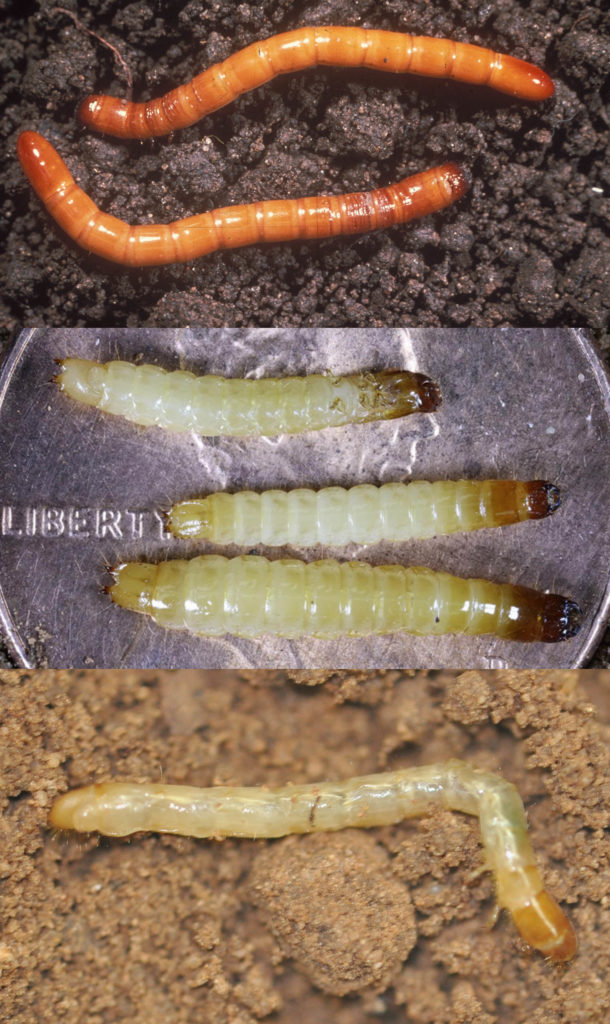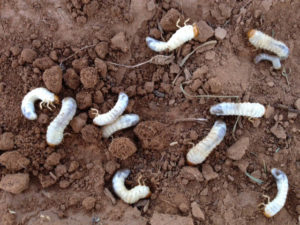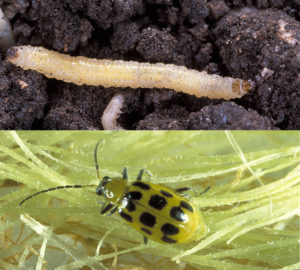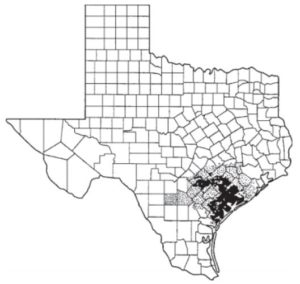Wireworms

True wireworms and false wireworms
True wireworms (Elateridae) and false wireworms (Tenebrionidae) are the immature stages of click and darkling beetles, respectively. Wireworms are usually shiny, slender, cylindrical, hard bodied, and yellow to brown (Fig. 3).
Wireworms feed on planted sorghum seed, preventing germination. To a lesser degree, they feed on seedling plant roots, reducing plant stands and vigor.
Several cultural practices can reduce wireworm abundance and damage in sorghum:
• Cultivating to reduce noncrop plant material
• Preparing good seedbeds
• Planting when soil moisture and temperature are adequate to promote rapid seed germination
• Planting in a field where a tap-rooted crop such as cotton was grown the previous year
Before planting, sample sorghum fields to determine whether you need to use insecticide-treated seed or to apply an insecticide at planting (Table 1). Sampling methods include soil examination and bait trap installation.
Examine the soil: Examine a 1-square-foot area of soil to 4 inches deep. Repeat at several locations in the field. If you find one or more wireworms per square-foot sample, treat either the seed or the soil with an insecticide at planting.
Set bait traps:
Two or more weeks before planting, install one bait trap for each 10 to 20 acres, following these steps:
1. Place 6 to 12 ounces of sorghum seed (not treated with insecticide) in a hole 4 inches wide and 6 to 8 inches deep in the field.
2. Cover the hole with soil and mark the trap with a stake.
3. Cover the trap area with a 4- by 4-foot sheet of black plastic to warm the soil and make the trap more effective.
4. Install one trap for each 10 to 20 acres.
5. Two weeks later, examine the grain in the trap and count the wireworms. If the bait traps average two or more larvae each, consider treating either the seed or the soil with an insecticide at planting.
Table 1. Insecticides labeled for wireworms in grain sorghum. Follow label directions.
| Active ingredient | Insecticide | Mode of action | Rate | Remarks | REI1 | PHI2 |
| Seed treatment | ||||||
| clothianidin | Poncho 600, NipsIt Inside | 4A | 5 .1–6 .4 fl oz/100 lb seed | — | 12H | — |
| imidacloprid | Gaucho 600, generics | 4A | 6 .4 fl oz/100 lb seed | Do not graze or harvest for forage within 45 days, and fodder or grain within 100 days of planting . | 12H | 45 days grazing |
| thiamethoxam | Cruiser 5FS | 4A | 5 .1–7 .6 fl oz/100 lb seed | — | 12H | 45 days |
| At-planting treatment | ||||||
| terbufos | Counter 20G Lock n’ Load | 1B | 5 .2 oz/1000 row ft, any row spacing | At planting time; banded or knifed in . Do not place granules in direct contact with seed, as they may injure the crop . Apply no more than 11 .3 lb/A . Do not use banded applications for aphid control in West Texas . Restricted use | 48H | Do not graze or harvest forage within 50 days, and fodder or grain within 100 days |
| Counter 15G Lock n’ Load | 7 oz/1000 row ft, any row spacing | 48H | ||||
| Counter 15G Smartbox | 7 oz/1000 row ft | 48H or 72H where average rainfall < 25 in ./yr |
||||
| Counter 20G Smartbox | 5 .2 oz/1000 row ft | Can be applied at bedding, banded, or knifed in . If applied at planting, do not treat at postemergence or cultivation . Restricted use | ||||
| 1: REI = Restricted entry interval 2: PHI = Preharvest interval | ||||||
Red imported fire ant
Under some conditions in East and South Texas, red imported fire ants (Solenopsis invicta) feed on planted sorghum seed. Worker ants chew through the thin seed coat and remove the embryo (germ). They rarely consume the endosperm (starch) of the seed. Although the ants prefer water-soaked or germinating seeds, they also damage dry seeds.
To reduce damage by red imported fire ants, use the cultural management practices recommended for wireworms. Use seed with good vigor, and plant it into a well-prepared seedbed when the soil temperature and moisture are adequate for rapid seed germination. Pack the covering soil firmly to prevent easy access of fire ants to the planted seed.
Table 2. Insecticides applied as seed treatments and labeled for fire ants in grain sorghum. Follow label directions.
| Active ingredient | Insecticide | Mode of action | Rate | Remarks | REI1 | PHI2 | |
|
Seed treatment |
|||||||
| imidacloprid | Gaucho 600, generics | 4A | 6.4 fl oz/100 lb seed | Do not graze or harvest for forage within 45 days, and fodder or grain within 100 days. | 12H | 45 days grazing | |
| thiamethoxam | Cruiser 5FS | 4A | 5.1–7.6 fl oz/100 lb seed | — | 12H | 45 days | |
| 1: REI = Restricted entry interval 2: PHI = Preharvest interval |
|||||||
Insecticide seed treatments labeled for red imported fire ants may protect seed from damage (Table 2). Applying a granular or liquid insecticide in-furrow at planting may also provide effective control.
White grubs

White grubs (Phyllophaga crinita and others) are the larvae of May or June beetles. They are characteristically C-shaped with white bodies and tan to brown heads and legs (Fig. 4). Because the last abdominal segment is transparent, dark-colored digested material is visible in the larvae. Their size varies by age and species.
Grubs damage sorghum by feeding on the roots. They may kill small seedlings, causing stand loss. If the grubs severely prune the roots of larger plants, they may lodge, be stunted, or become more susceptible to drought and stalk rot organisms.
White grubs are rarely serious pests of sorghum. However, because they cannot be controlled once the crop has been planted, you must determine before planting whether they are present in the soil. Examine 1 square foot of soil in each 5 to 10 acres. If white grubs average one per square foot, consider applying turbos in a band at planting. Sorghum seed treated with clothianidin is labeled for control of white grubs (Table 3). Planting sorghum in a field where a nongrass crop (such as cotton or soybean) was grown the previous year is the most important cultural management practice for control of white grubs.
Table 3. Insecticides labeled for white grubs in grain sorghum. Follow label directions.
| Active ingredient | Insecticide | Mode of action | Rate | Remarks | REI1 | PHI2 |
| Seed Treatment | ||||||
| clothiandin | Poncho 600, Nipsit Inside 5 | 4A | 5 .1–6 .4 fl oz per 100 lb seed | – | 12H | – |
| At-planting treatment | ||||||
| terbufos | Counter 20G Lock n’ Load | 1B | 5 .2 oz/1000 row ft, any row spacing | At planting time; banded or knifed in . Do not place granules in direct contact with seed, as it might injure the crop; no more than 11 .3 lb/A . Do not use banded applications for aphid control in West Texas . Restricted use | 48H | Do not graze or harvest forage within 50 days, and fodder or grain within 100 days |
| Counter 15G Lock n’ Load | 7 oz/1000 row ft, any row spacing | |||||
| Counter 15G Smartbox | 7 oz/1000 row ft | 48H or 72H where average rainfall is less than 25in/year | ||||
| Counter 20G Smartbox | 5 .2 oz/1000 row ft | Can be applied at bedding, banded or knifed in . If applied at planting, do not make postemergence or cultivation time treatments . Restricted use | 48H | |||
| 1: REI = Restricted entry interval 2: PHI = Preharvest interval |
||||||
Southern corn rootworm

The adult southern corn rootworm (Diabrotica undecimpunctata howardi) is also called the spotted cucumber beetle. The adult overwinters in surface debris but may become active during warm weather. In early spring, the females deposit eggs in the soil around the base of plants. There are two generations per year.
The larvae are small, brown-headed worms with wrinkled, creamy white skin (Fig. 5). They chew into germinating seeds, roots, and crowns of sorghum plants. The symptoms of rootworm damage include reduced stands, lower plant vigor, and the occurrence of dead heart, or the death of the newest growth in the central whorl of young plants. Later in the season, maturity may be delayed, the plants may lodge, and weeds may multiply because the plant stand is not

uniform. The shaded areas on the map (Fig. 6) indicate where the pest is most likely to damage sorghum in Texas.
Cultural management practices include keeping fields clean of grassy weeds, plowing or disking 30 days before planting, planting early, and planting at a slightly higher than normal seed rate.
Apply insecticides labeled for control of southern corn rootworm at planting time or postemergence (Table 4). Base the need for insecticide treatment on the field’s history of damage by rootworms.
Table 4. Insecticides labeled for controlling southern corn rootworm. Follow label directions.
| Active ingredient | Insecticide | Mode of action | Rate | Remarks | REI1 | PHI2 | |
| At-planting treatment | |||||||
| chlorpyrifos | Lorsban 15G | 1B |
|
At planting, T-banded applications | 24H | – | |
| terbufos | Counter 20G Lock n’ Load | 1B | 5.2 oz/1000 row ft, any row spacing | At planting time; banded or knifed in . Do not place granules in direct contact with seed,as it may injure the crop; no more than 11 .3 lb/A . Do not use banded applications for aphid control in West Texas . Restricted use | 48H | Do not graze or harvest forage within 50 days, and fodder or grain within 100 days | |
| Counter 15G Lock n’ Load | 7 oz/1000 row ft, any row spacing | ||||||
| Counter 15G Smartbox | 7 oz/1000 row ft | ||||||
| Counter 20G Smartbox | 5 .2 oz/1000 row ft | Can be applied at bedding, banded, or knifed in . If application is made at planting, do not treat at postemergence or cultivation . Restricted use | 48H or 72H where average rainfall is < 25 in ./year |
||||
| 1: REI = Restricted entry interval 2: PHI = Preharvest interval | |||||||
